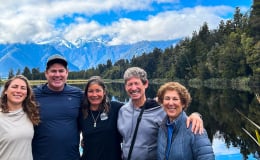
Hiking Preparation - 5 Tips To Get Ready

The great outdoors runs through our veins here in New Zealand. We grow up running around in bare feet, exploring the nature that is never far away, even in the most urban areas of New Zealand. We are very lucky, and we know it! Nothing makes us feel more proud than hearing stories of how much travellers love our country and the natural splendour it offers.
It's easy to spend time on our trails while you're visiting - anyone with a reasonable level of hiking fitness can enjoy walking in New Zealand - but if your plans are a little more ambitious or you're keen to take on one of our slightly more active tours like the Kiwi Classic or Pure South, it helps to be prepared. Here are some tips to help you enjoy the best hiking New Zealand has to offer (so you will go home and tell all your friends how awesome New Zealand is too!).
1. Give yourself time to prepare
Allowing yourself time to prepare before your trip to New Zealand is a smart idea to ensure a comfortable hiking experience when you arrive. It can take six to eight weeks to feel the results of an exercise regime, however, depending on what you want to achieve while in New Zealand, anything helps.

Training for hiking will give you a more comfortable New Zealand hiking experience.
Just keep in mind that what might seem easy when you are in your own backyard can become a little different when you travel. There are a number of things that can contribute to this, such as being on the move more than when you are at home and your body adjusting to a new time zone and climate. All of this can make walking in New Zealand a bit different than it would be in your own environment.
We do have options to suit all abilities (even wheelchair accessible trails) here, so everyone can experience the beauty of New Zealand.
2. Pick the right type of trail for you
We have so many great trails here in New Zealand that it can be hard to choose. To help make it easier for you, we've created multi-day trips which include the 'must-see' spots and some of our favourite hidden gems here in New Zealand, while having options to suit people with different levels of hiking fitness. If you want to get a better idea of which trip would suit you, view our trips side-by-side here.
To find out more detailed information about the distance, duration and elevation gain of all the hikes and activities on our trips, you can take a look at out fitness guides here for the World Heritage, Masterpiece, Kiwi Classic, Pure South and Sweet North.

Check out our hiking fitness guides for all our tours with information on the distance, duration and elevation gain of all hikes and activities.
The trails in New Zealand can generally be split into the following five categories:
Easiest Walks – easy trails of up to an hour long, suitable for most ages and fitness levels (such as one of the many short walks found on the Haast Highway).
Easy Walks – gentle walking for up to a day. An example is the Hooker Valley Walk at Aoraki/Mt Cook (included on all our South Island tours). Suitable for people with low – moderate walking fitness, the trails are relatively flat (see tip 5 for translation) with some rocky or muddy areas.
Intermediate Tracks – this covers our Great Walks (like the famous Milford Track) and slightly challenging multi-day and day hikes. The Tongariro Crossing is a great example of an intermediate track (included on our Sweet North tour). This track is often underestimated, as it is a day walk, however it is long with steep uphill and downhill sections that will challenge some casual walkers. These trails are more suited to people with hiking experience and reasonable fitness.
Advanced Tracks – these are day or multi-day trails that are suited to experienced hikers. They usually venture into mountainous areas with route finding (trail only marked with poles), exposed areas (e.g. open ridgelines) and uneven terrain. People should only undertake this trail type if they have ample backcountry (multi-day/remote) hiking experience and a good level of fitness. If you are fit and want the challenge of an advanced trail in New Zealand, but lack the backcountry experience, then a guided option could be for you. Our Kiwi Classic tour encompasses some of our more challenging trails including a multi-day hike into the mountainous areas of the Nelson Lakes National Park and the Mueller Hut/Sealy Tarns day walk in Aoraki/Mt Cook, which boasts some of the most incredible views anywhere in New Zealand!
Expert Tracks – these trails are only for very experienced hikers, those that have exceptional backcountry/remote hiking experience, navigation and survival skills. These trails are typically sparsely marked and rarely walked so trail finding and navigation skills are a must. Unbridged, rough, rocky and steep terrain can be expected. Only attempt these tracks if you are confident and fully prepared – and ALWAYS register your intentions (tell someone when you're going and when you expect to be back)! A good example of an expert track is the Ball Pass Crossing in Aoraki/Mt Cook, which requires the use of crampons and ice axes.
3. Up your fitness

Practice makes perfect, training for hiking to get the most out of your New Zealand trip.
- Work on your leg strength. Being such a mountainous nation, as you can imagine there is a fair bit of walking up and down hills. What surprises some people is how challenging the downhill can be. This is where leg strength comes in; you need cardio fitness for the uphill and leg strength for the downhill. A great exercise for this is step-ups, however, if you have knee problems it would be a good idea to consult your GP or physiotherapist before undertaking exercises that stress the knee joints.
- Another great way to sneak in some preparation during the day is opting to take the stairs rather than the elevator, both up and down. This is a fantastic way to help those leg muscles get used to walking up and down on a regular basis.
- It goes without saying – hit the trails! There is nothing better than hiking to prepare for a hiking trip. Start off easy on yourself; don’t jump in to the hardest trail around your area if you are not ready for it. That is the quickest way to feel defeated! Rather, set that trail as a goal and work your way up to it. Or, go on mini hiking vacations. Take a weekend away to the mountains, or a popular hiking destination in your country. Work on your stamina, the most popular day hikes in New Zealand are from 3 – 5 hours long so make sure to throw some longer walks into your routine.
- Cardio is important, and what typically stops people in their tracks. Some people get a shortness of breath and mistake the cause of this to be altitude, but in New Zealand our mountains are so low there are no altitude issues. It usually comes down to not having enough cardio fitness. You'll be better off if you do some cardio work before starting an active trip, and slow down/take a break if you start to feel out of breath; you will enjoy the hike so much more if you do.
- While we put a lot of work into maintaining our trails in New Zealand, it’s still out in nature and as such, hiking here can involve some form of uneven terrain. Whether it is rocks or tree roots we have to contend with, balance is important. A way to check your balance is to try walking unassisted in a straight line heel to toe. If you struggle to do this, there are some exercises that can help improve your balance. Try standing on one leg for 60 seconds then switch to the other and repeat this four times. Take this exercise one step further and do leg swings, swing one leg out in front of you and then swing it behind in a pendulum motion, repeat as per the first exercise. Another option is to keep practicing the heel-toe walk, or if you have access to a balance board or cushions (most gyms have these), practice balancing on these. Always remember safety though, make sure objects are out of the way and that you have a wall or stable object to grab onto if needed. Hiking poles definitely help when it comes to balance, however, you can’t rely solely on them.
- Train the brain. Travel pushes most people out of their comfort zone; this is what makes it so thrilling right? Be prepared that you may be pushed outside your comfort zone at some point. It could be a short burst of inclement weather, intentionally pushing yourself on a hike that’s a little more challenging than you are used to, trying a bungy jump for the first time, or it could be overcoming a fear of heights by walking over a swing bridge. Be prepared to push yourself, and reap the rewards with the incredible satisfaction (and bragging rights) that come with such achievements.
- Ensure you consume enough energy for the work you are doing. Sometimes you just don’t feel like eating much when you are out hiking, especially on multi-day treks... but your body needs energy to keep you going. If you don’t feel like eating, consider taking high-energy snacks or water mixes to top you up and keep you going until you are ready to eat.
- There are numerous benefits to using hiking poles. Studies have shown that hiking poles reduce pressure strain on the opposite leg by 20%. When walking on flat ground with hiking poles, this reduces the body weight carried by the legs by 5kg (11 pounds) and 8kg (18 pounds) when going uphill. It helps to practice using hiking poles before you go on a hiking holiday, so you don't end up fumbling with them when you would rather be checking out the awesome scenery. Check out our tutorial on how to use hiking poles correctly.
- In New Zealand, you may choose to carry a small backpack even on our shorter walks. Weather can change fast and being prepared ensures a comfortable hike. Items to pack in a day pack include plenty of layers, wet weather gear, water and snacks – generally a day pack will weigh around 5 – 7 kg (11 – 15 pounds). For multi-day hikes in New Zealand, on average hikers will need a 60L pack and generally start with a weight of between 15 – 18kg (33 – 40 pounds). This is typical for a 3-day hike, but it may weigh more or less depending on the duration of your hike or if you are an ultra-light hiker. A good way to prepare for a multi-day hike in New Zealand is to find a hill near your home, put your loaded backpack (use full water bottles to increase the weight) on your back and hike up AND down the hill as often as you can. This will help build the right type of leg strength and get your body used to carrying a pack.
- Do all of this while wearing the boots you intend to hike in! Contrary to popular belief, you don’t wear your boots in; they wear your feet in. This way you can check for hotspots, discomfort, toe space etc. before you arrive in New Zealand. If you do have issues with your boots then visit your nearest outdoor store for advice on fixing these issues.
4. Learn some kiwi hiking lingo
Flat – some kiwis are notorious for underplaying things and the word flat can be no exception. Flat in New Zealand can mean flat, or it can mean gently undulating with some ups and downs. It's always a good idea to find out how flat (or undulating) your walk is beforehand. As far as our trips go, you can take a look at our handy fitness guides for our World Heritage, Masterpiece, Kiwi Classic, Pure South and Sweet North tours to see specific elevation information for each of our hikes and activities!

Even the most exaggerative kiwi wouldn't call this flat...
Tramping/tramp – this term is the kiwi word for hiking. A tramp is a multi-day hiking trail, and tramping is walking on said trail. Other countries may refer to this as backpacking or trekking.
Backpacking – we generally refer to multi-day hikes where taking a backpack is necessary. But this term can also be used for people who are travelling on a budget, staying in youth hostels or backpackers and typically carry a backpack.
DOC – Department of Conservation (Government department responsible for our natural environment including our hiking trails and huts).
Going for a walk – if a kiwi asks you if you want to go for a walk, it may not necessarily be the gentle stroll you were envisioning! Walking can be a short stroll or a day hike in New Zealand and can range from an easy amble to a challenging climb up a mountainside. If it can be done in a day, it’s a walk!
Going bush – while this term is used extensively in Australia and South Africa, it has a slightly different meaning in New Zealand. Going bush generally refers to going off track. Usually reserved for hunters who “go bush” to track their prey or for adventurers who wish to blaze their own trail (only for the accomplished backcountry hiker with navigation and survival skills).
Backcountry – this is similar to going bush, but refers more to alpine regions. If a hunter is hunting in the backcountry, they are likely hunting in an alpine area (usually involves a helicopter for transportation). A tramper will be going to more remote trails, which usually involve alpine elements, and the last is for farmers who work on stations (New Zealand equivalent of ranch) and are heading out to the more remote areas of the farm.
5. Learn New Zealand’s hiking trail etiquette
Take only photos, leave only footprints – we kiwis are very protective of our natural environment, which of course means no littering!

Know your hiking trail etiquette. Keep left - we drive on the left and we hike on the left.
Say Hello to fellow hikers – it is common in New Zealand to say “hi” to anyone that you pass on the trail. It’s polite and pleasant, and sometimes you can strike up a fascinating conversation with a stranger. If you wish to up the ante, then practice your Maori by greeting people with kia ora!
Allow faster walkers to pass and be polite if you are a fast walker. If you hear someone walking behind you, pull over and let them past. It’s also easy not to hear if someone is behind you, so if you are a fast walker, politely ask if you can pass.
Stick to the marked tracks. This isn’t just for your safety but to protect our eco system too. There are areas that are precious with plants that can take hundreds of years to grow, and trampling over them can cause significant (and sometimes irreversible) damage to these eco-systems.
Be considerate when hiking in groups. Try not to take up the whole trail while walking side by side. Other people are using the trail too, so keep it to two abreast and be aware of the needs of other hikers.
Enjoy nature and let others do so too – keep the noise down, no smoking, use headphones instead of playing music through your speakers. If you see people ahead stopped on the trail, slow down. They may have a bird coming in close to them which you could enjoy too. Also, if you are at a viewpoint, take your photos and move away to allow others to take photos.
Share your intentions. This is not necessary on one of our small group tours as you'll have our team looking after you, and we have undertaken painstaking preparation to ensure your safety at all times. But if you are going on a trail alone (especially a multi-day hike), then make sure to let someone know where you are going, and when you expect to return. Also, fill in your name and date in the hut books if you are staying in DOC huts. If you become injured or lost then registering your intentions will narrow the search area.
We hope these handy tips will help you get trail ready for your hiking adventure in New Zealand! You can have a look at our trip schedules and availability on our availability page. To work out which trip suits you best, check out Which Trip is Right For Me.
Request your FREE NEW ZEALAND TRAILS Brochure here now for articles, stories and information on our 5 guided trip options.
Other articles you may like:
- What’s the best time for hiking in New Zealand?
- What to pack for New Zealand
- Flights to New Zealand - how to get to here
- Get your free New Zealand Trails guided tour brochure








